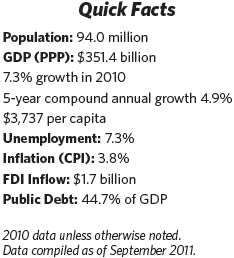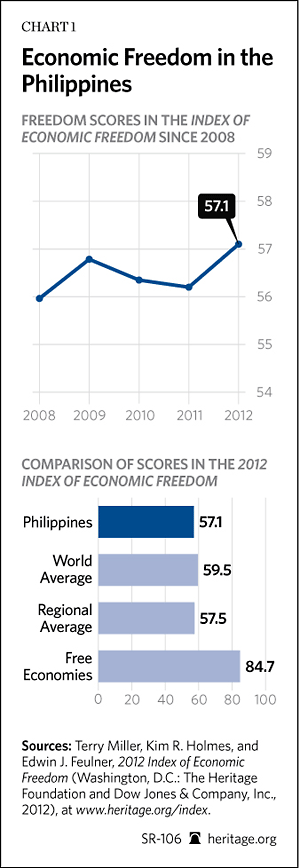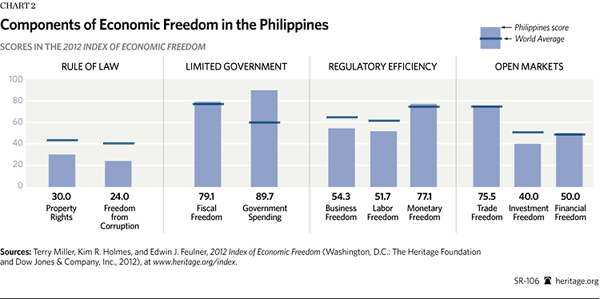Executive Summary
In 2010, President Benigno S. (“Noynoy”) Aquino III made a pledge to voters: If elected, he would reduce long-standing and endemic corruption in the Philippines. While such reform is indeed underway, as the 2012 Index of Economic Freedom makes clear, there is still much work to be done.
The Philippines is a diverse country. Its population of 94 million speaks more than 80 languages and is spread out over 7,000 islands in the Western Pacific Ocean. With a score of 57.1 in the 2012 Index of Economic Freedom published by The Heritage Foundation and The Wall Street Journal, the Philippines is the 107th freest nation in the world; among its neighbors in the Asia-Pacific region, it is ranked 19th out of 41 countries. Despite the challenging global economic environment, the Filipino economy reached a three-decade high per capita economic growth rate of 7.3 percent real growth of GDP in 2010 before slowing down to 3.7 percent in 2011.
 The 2012 Index report for the Philippines notes some successes in recent years—such as enhancement of the country’s entrepreneurial environment and the development of a stronger private sector—but cautions that progress has been mixed. The government imposes formal and nonformal barriers to foreign investment, and foreign remittances do little to promote sustainable growth. Furthermore, the judicial system remains weak and vulnerable to political influence and corruption.
The 2012 Index report for the Philippines notes some successes in recent years—such as enhancement of the country’s entrepreneurial environment and the development of a stronger private sector—but cautions that progress has been mixed. The government imposes formal and nonformal barriers to foreign investment, and foreign remittances do little to promote sustainable growth. Furthermore, the judicial system remains weak and vulnerable to political influence and corruption.
The 2012 Index report identifies four interrelated areas where deeper institutional reforms are required: business freedom, investment freedom, property rights, and freedom from corruption. This paper will examine those areas in greater detail.

Lagging Behind
In examining why economic growth in the Philippines has lagged behind other Asian countries (e.g., Indonesia, Malaysia, and Thailand), a December 2011 report by the International Monetary Fund (IMF) cited several concerns:
- Relatively low investment compared to the rest of emerging Asia;
- Fiscal pressures due to weak revenue performance;
- Weighty debt service, and high input costs put a strain on government spending;
- Conglomerates serve as a disincentive for private sector investment.[1]
The report also noted that the Filipino economy continues to be impacted by the lingering effects of protectionist and import-substitution policies dating from the end of the Second World War.
 Under the past several presidents, the government of the Philippines has pursued a series of legislative and structural reforms designed to enhance the country’s entrepreneurial environment. Such reforms include strong trade liberalization, the reduction of fiscal deficits, and constitutional alterations that strengthened the legislative branch. To generate sufficient future revenue for additional improvements to infrastructure, the IMF report advises that the government of the Philippines should improve tax administration, reform excise taxes, rationalize fiscal incentives, and address exemptions in value-added taxation.[2]
Under the past several presidents, the government of the Philippines has pursued a series of legislative and structural reforms designed to enhance the country’s entrepreneurial environment. Such reforms include strong trade liberalization, the reduction of fiscal deficits, and constitutional alterations that strengthened the legislative branch. To generate sufficient future revenue for additional improvements to infrastructure, the IMF report advises that the government of the Philippines should improve tax administration, reform excise taxes, rationalize fiscal incentives, and address exemptions in value-added taxation.[2]
Developing a stronger private sector is crucial to generating broad-based job growth. While the International Monetary Fund recently praised the country “for sound monetary and fiscal policies,”[3] and regulatory efficiency has been enhanced, overall progress on pro-business reforms has been gradual. Indeed, after making progress in 2011, the Philippines’ business freedom ratings have declined.[4]
There are other institutional challenges that will require President Aquino to maintain a deep commitment to reform. For instance, corruption continues to be a serious cause for concern. In the 2012 Index of Economic Freedom, the Philippines’ score on the “Freedom from Corruption” indicator is the lowest score the country received in any Index category—it ranks only 136th out of 179 countries.[5] Clearly, corruption is undermining the Philippines’ long-term economic development.
Furthermore, the country’s Index score was hampered by several other factors: its judicial institutions, which remain susceptible to political interference; its failure to protect property rights; and law enforcement that lacks sufficient strength and transparency.
As a result of these lingering shortcomings, the Philippines—once home to one of emergent Asia’s more advanced economies—has been eclipsed by its neighbors’ higher rates of economic growth. The Filipino economy relies heavily on emigrants’ remittances—which equate to more than 10 percent of GDP. According to a group of Filipino and international business executives that produced an advocacy paper in December 2010 entitled “Arangkada,” this reliance on human capital exports puts the Philippines at risk of contracting a form of “Dutch Disease 2.0.”[6]
Endemic and Entrenched Corruption—A Serious Problem
The corruption score is derived from the Corruption Perceptions Index, published annually by Transparency International.[7]
However, the 2012 Index chapter on the Philippines reports that the country is in the lower half of world scores not only on corruption, but also on Property Rights (97th out of 179 countries)[8]
Although the Philippines has procedures and systems for registering claims on property— including intellectual property and chattel/mortgages—delays and uncertainties associated with a cumbersome court system continue to concern investors. Questions regarding the general sanctity of contracts and the property rights they support have also clouded the investment climate. Furthermore, the judicial system is weak: Judges are nominally independent, but some are corrupt or have been appointed for political reasons. Organized crime is a serious concern, and despite some progress, enforcement of intellectual property rights remains problematic.
An April 2011 World Bank progress report noted that the investment climate in the Philippines is constrained by lack of trust. Specifically, investors doubt whether the country’s institutions “have functional self-regulatory mechanisms, and that transparency and disclosure principles are respected and governance mechanisms are effective.”[9] As the December 2011 IMF report cited above pointed out, “corruption and political instability are unique in the Philippines in its unpredictability and extent.”[10]
According to the U.S. Department of State’s 2011 Investment Climate Statement the Philippines has yet to sign the Organization for Economic Co-operation and Development (OECD) Convention on Combating Bribery; it did, however, ratify the U.N. Convention Against Corruption. The State Department report also notes some other positive developments, such as:
- The development of a Revised Penal Code, the Anti-Graft and Corrupt Practices Act, and the Code of Ethical Conduct for Public Officials, which are all aimed at combating corruption and related anti-competitive business practices; and
- The Office of the Ombudsman, which investigates and prosecutes cases of alleged graft and corruption involving public officials, with the “Sandiganbayan,” or anti-graft court, prosecuting and adjudicating those cases.[11]
The Ombudsman, however, is understaffed and lacks the authority that could strengthen its investigative capacity and lead to increased prosecution of cases. Fortunately, amendments to strengthen these powers are before the Filipino Congress. The Sandiganbayan faces a huge backlog of cases and is seeking an increase in salas (regional trial court branches) and a change in the rules that would allow one justice—rather than the currently mandated three—to hear a case.
In addition to weak institutions and political corruption, low-level corruption in the Philippines is also a serious problem. The Hong Kong-based Political & Economic Risk Consultancy (PERC) group ranks the Philippines (along with Indonesia and Vietnam) as having significant institutional corruption; PERC reports that the military is the most corrupt Filipino institution, followed by the tax and customs bureaus and the police. The institution viewed as the least corrupt, however, was the stock market.[12] Like political corruption, such low-level venality has been cited as “a reason often given in the past [by members of the international business community] for not investing in the Philippines.”[13]
A Mandate to Fight Corruption
When President Aquino took office in 2010, he did so with a mandate to address long-standing and pervasive government corruption—a charge he has taken seriously. Indeed, in his inauguration speech the President admonished “those who have been put in positions by unlawful means” and issued a warning to “those who intend to continue the crooked ways that have become the norm for too long.”[14]
As promised, President Aquino has, thus far, fixed his sights on graft, judicial corruption, and election fraud. After only three months in office, Aquino’s very first Executive Order established a “Truth Commission” designed to “investigate irregularities by former state officials.”[15]
President Aquino’s first target for corruption prosecution was former Ombudsman Merceditas Gutierrez. According to press reports, Aquino’s legal team called for Ms. Gutierrez’s impeachment for failing to look into various alleged scams during the previous administration, but “Gutierrez resigned before she could be prosecuted.”[16]
Presently, Filipino media attention is focused on several even higher-profile and politically significant cases. Late last year, former President Gloria Macapagal-Arroyo was arrested and charged with “tampering with election results in 2007” and (along with her husband) “corruption related to a $329 million broadband contract with a Chinese firm.”[17]
The Economist Intelligence Unit (EIU) reports, however, that President Aquino’s “attempts to investigate Ms. Macapagal Arroyo have been stonewalled by a judiciary that is dominated by his predecessor’s appointees.”[18] President Aquino would not permit the Supreme Court’s Chief Justice, Renato Corona (an appointee and close confidant of President Macapagal-Arroyo), to administer the oath of office at his inauguration in 2010—although the rest of the Supreme Court, most of whose incumbent members had been appointed by former President Macapagal-Arroyo, stood by Justice Corona.[19]
However, as part of the wave of reform sweeping the nation, in January 2012 the Philippine Senate began an impeachment trial of Chief Justice Corona on charges of “betraying the public’s trust through his ‘partiality and subservience’ in cases involving the previous president … as well as corruption and violating the constitution.”[20]
Press reports confirm the EIU’s conclusion that, thus far, “procedural rulings by the Senate have been broadly in Justice Corona’s favour.”[21] The New York Times notes that in a “surprise move” at the end of February prosecutors rested their case “after presenting evidence on only three of eight articles of impeachment” and that the trial has “been marked by tedious procedural issues that have left senators, who are acting as trial judges…angrily lecturing the prosecutors.”[22]
Meanwhile, The Guardian reports that “critics have called the proceedings an opportunity for Aquino to clear the government of Arroyo supporters and strengthen his own power.”[23] Prosecutors allege that Chief Justice Corona has “more than $1 million in undeclared assets and that although he owned only a few properties” when he was appointed to the court a decade ago by President Macapagal-Arroyo “he now owns more than 20. The prosecution contends that he was able to enrich himself because of his alliance with Mrs. Arroyo and that in return he issued rulings in her favor.”[24]
Other Economic Freedom Indicators More Positive
In the 2012 Index, the Philippines scores best on Government Spending (19th out of 179 countries) and is in the upper half of world scores on Fiscal Freedom (86th).[25] Total government expenditures, including consumption and transfer payments, held steady at 17.3 percent of GDP during the rating period (July 1, 2010, through June 30, 2011). Fiscal stimulus and restructuring of public enterprises have widened the fiscal deficit, which, in 2007, had almost reached zero.
Limited Government. The top tax rate on personal income is 32 percent, and the top corporate tax rate is 30 percent. Other taxes include a value-added tax (VAT), “a 12 percent value-added tax levied on a wide variety of products including petroleum and petroleum products,”[26] and an environmental tax; overall taxes collected amounted to 12.8 percent of total domestic income in 2010. There are also excise taxes on alcohol, cigarettes, and tobacco.
Government spending is equivalent to 18.5 percent of GDP and the deficit has been over three percent of GDP. Although external debt has declined steadily in the past decade and now totals only about 30 percent of GDP,[27] total (gross) public debt reported by the Government of the Philippines to the International Monetary Fund (which includes domestic public debt) remains stuck at around 45 percent of total domestic output.[28]
According to the CIA Factbook, the Aquino Administration “is working to reduce the government deficit from 3.9 percent of GDP…to 2 percent of GDP by 2013. The administration has already reduced [the stock of] public debt to below 50 percent of GDP and obtained several ratings upgrades on sovereign debt.”[29]
Regulatory Efficiency. According to the 2012 Index, the Philippines scores relatively highly in some components of the Regulatory Efficiency category, such as Monetary Freedom (74th out of 179 countries). However, the country’s scores on business freedom and labor freedom (135th and 124th, respectively) demonstrate many areas for improvement.
Inflation has been relatively moderate, averaging 4.2 percent between 2008 and 2010, and is forecast to average 4.6 percent per year between 2012 and 2016—a result of lower international prices for oil and non-oil commodities. The government influences prices through state-owned enterprises and utilities, and controls the prices of electricity distribution, water, telecommunications, and most transportation services. Price ceilings are usually imposed on basic commodities only in emergencies, and presidential authority to impose controls to check inflation or ease social tension is rarely exercised. Ten points, however, were deducted from the Philippines’ monetary freedom score in the 2012 Index to account for measures that distort domestic prices.
The business regulatory environment in the Philippines has improved, although launching a business still takes more than the world averages of seven procedures (15 procedures in the case of the Philippines) and 30 days (35 days for the Philippines).[30] However, as the Arangkada report notes, foreign investors can set up in economic zones very quickly and efficiently and have smooth working relationships with the Philippine Economic Zone Authority (PEZA). Almost 800,000 Filipinos work in these economic zones.[31]
Furthermore, the time and cost involved in dealing with licensing requirements have been notably reduced. The labor market remains structurally rigid, although existing regulations are not particularly burdensome. The central bank and finance officials have kept inflation relatively moderate (3.75–4.25 percent).[32]
Nevertheless the 2011 U.S. Department of State “Investment Climate Statement” for the Philippines notes that while the government maintains a “minimal level of transparency in the rulemaking process” on “the enforcement side…regulatory action is often weak, inconsistent, and unpredictable. Regulatory agencies in the Philippines are generally not statutorily independent, but are attached to cabinet departments or the Office of the President and, therefore, subject to political pressure.”[33] Regulatory agencies are often also operating agencies, creating conflict of interest situations (e.g., the Philippine Ports Authority both operates and regulates ports; the Philippine Amusement and Gaming Corporation (PAGCOR) operates and regulates casinos).
The 2012 Index score illustrates that although existing labor regulations are not particularly burdensome, the Philippines’ labor market remains structurally rigid. As a result, many of the country’s skilled workers have migrated to other advanced economies.
Open Markets. Finally, in the area of Open Markets, the 2012 Index report for the Philippines shows that all of the areas measured by the indicators could benefit from further reform: Trade Freedom (93rd out of 179 countries); Investment Freedom (117th); and Financial Freedom (72nd). Total government expenditures, including consumption and transfer payments, held steady at 17.3 percent of GDP during the rating period (July 1, 2010, through June 30, 2011). Fiscal stimulus and restructuring of public enterprises have widened the fiscal deficit, which had almost reached balance in 2007.
The Philippines’ small financial sector is dominated by banking. In general, the financial system welcomes foreign competition, and capital standards and oversight have improved. Consolidation has progressed, and nonperforming loans have gradually declined. The banking sector is controlled by five large commercial banks; two large state-owned banks account for about 15 percent of total assets. Credit is generally available at market terms, but banks are required to lend specified portions of their funds to preferred sectors. The non-bank financial sector remains small. Capital markets are centered on the Philippine Stock Exchange. The impact of the global financial crisis on banking has been relatively small because of the sector’s very limited exposure to distressed international financial institutions.
Foreign investment is restricted in several sectors of the economy. In many industries where foreign investment is allowed, the level of foreign ownership is capped. All foreign investments are screened and must be registered with the government. Regulatory inconsistency and lack of transparency, corruption, and inadequate infrastructure hinder investment. Dispute resolution can be cumbersome and complex, and enforcement of contracts is weak. Residents and non-residents may hold foreign exchange accounts. Payments, capital transactions, and transfers are subject to some restrictions, controls, quantitative limits, and authorizations. Foreign investors may lease but not own land.
The trade-weighted average tariff rate is at 4.8 percent[34] but a number of non-tariff barriers continue to hamper growth of trade. Despite the country’s expressed desire to attract longer-term foreign investment and a strong track record of investment recently (about 20 percent of GDP in the past two years),[35] further streamlining of inefficient government agencies could encourage additional dynamic growth in investment. The financial sector, which is gradually modernizing, remains relatively stable and sound.[36]
Among ASEAN countries, the Philippines had a “high utilization rate of preferential trade agreements in 2010. Philippine utilization rate rose to 41.15 percent, a marked increase from the 20 percent utilization rate in the 2008 survey of the Asian Development Bank (ADB).”[37]
The Philippines could benefit from additional global market opportunities through the Trans-Pacific Partnership (TPP). According to the Office of the U.S. Trade Representative (USTR), the United States “is ready to help the Philippines meet membership requirements” for the Trans-Pacific Partnership, “a Pacific free trade pact that the U.S. and eight other countries are negotiating.”[38]
Additional new trade benefits could flow from a U.S. Senate proposal, the “Save Our Industries Act” (SAVE Act), aimed at expanding U.S. trade with Asia by allowing apparel manufactured in the Philippines with U.S. fabrics to enter the country duty free. According to its sponsors, Senators Daniel K. Inouye (D–HI), Daniel K. Akaka (D–HI) and Roy Blunt (R–MO), the legislation could create “upwards of 2,000 jobs in the U.S. fabric mill sector while spurring an incentivized export market for the U.S. textile industry. With almost 99 percent of the U.S. apparel market now served by imports, U.S. textile manufacturers are reliant on export markets for their survival.”[39] Negotiations for a Philippines-EU free trade agreement, however, have yet to commence, as Philippines’ Trade and Industry Secretary Gregory L. Domingo insisted on wider consultations with “stakeholders” after the parties signed the Partnership and Cooperation Agreement in June 2011.[40]
Continued Reform: The Key to Filipino Economic Freedom
Along with the steady 10 percent of Filipino income that arrives in the country each year from emigrants’ remittances, the reforms already achieved in the monetary, fiscal, and banking sectors permitted the economy of the Philippines to weather the global financial crisis while maintaining the economic growth levels necessary to provide higher standards of living for all Filipinos. Further progress, however, is vital in the areas of rule of law, infrastructure modernization, regulatory efficiency, and governance.
President Aquino’s landslide victory in 2010 may have produced the stable political climate necessary to pursue the reforms advocated in this paper—critical reforms that will enhance economic growth and improve economic freedom in the Philippines. President Aquino is right to focus on corruption in his quest to reform government, although he will have to do so in an even-handed and productive manner.
Successful reforms during President Aquino’s term should result in improved scores for the Philippines in future editions of the Index of Economic Freedom.


